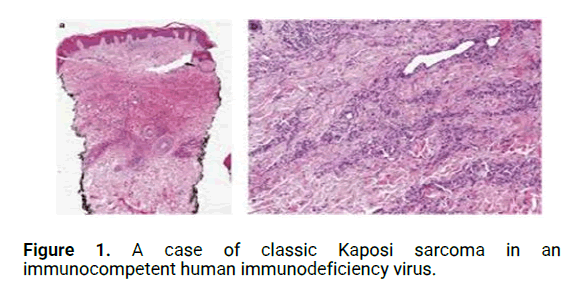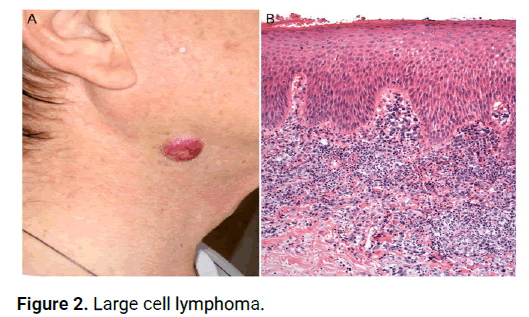Case Report - (2023) Volume 9, Issue 4
Kaposi sarcoma is a rare vascular tumour mainly described in immunocompromised patients, such as HIV infected individuals or transplant patients. We report a case of disseminated classical Kaposi sarcoma in a 79-year-old immunocompetent (non-HIV infected) man from Northern Territory, who did not have major comorbidities presented with papulo-nodular skin lesions distributed over upper, lower extremities and torso. His lesions were biopsied and pathological features were consistent with Kaposi sarcoma. He was managed conservatively with fine cautery and cryotherapy with significant improvement in the appearance of the lesions.
Kaposi sarcoma • Human immunodeficiency virus • Acquired immunodeficiency syndrome • Human herpesvirus 8 • Pneumonia
Although Kaposi sarcoma was first described by a Hungry born Viennese dermatologist in 1872 and later described in Italian patients by Tommaso de Amicis, it was not until the 1980’s when this disease became more apparent with the surge of HIV infection worldwide. Its association with HHV8 was described by Chang et al in 1994. KS is considered an AIDSdefining illness as it is the most common malignancy in HIV infected patients. Kaposi sarcoma develops from the endothelial cell. The interactions of the HHV8 virus with dysfunctional immunity develop the Kaposi sarcoma. Kaposi sarcoma shows four clinical subtypes that include classical, endemic, AIDS-associated (epidemic) and Iatrogenic (transplant) KS [1].
The classical KS is more common in Mediterranean and Jews descendants. Classic KS is rare with indolent behaviour. It is primarily cutaneous, but it may involve lymphatic and visceral organs such as gastrointestinal tracts and pulmonary system. The classical KS has also been reported in diabetic patients. Iatrogenic KS is more common in immunosuppressed individuals who are on immunosuppressive medications for autoimmune disorders or organ transplantation. Transplant patients on cyclosporine is the most common risk factor for the development of iatrogenic KS [2].
South Africa is considered an endemic region for KS, endemic KS, where it affects young children as well as elderly. The clinical course of endemic KS is rapidly progressive due to its predilection to lymphatic spread.
The most aggressive form of epidemic KS was described in 1981 in homosexual patients who have contracted HIV infection. The clinical manifestations provide a clinical clue to the diagnosis of AIDS. The oral KS form is more prevalent in AIDS patients [3]. The initial clinical presentations of the cutaneous KS present as plaques or patches, but later it can turn into some nodular forms. The symptomatology varies from being asymptomatic to painful, ulcerated nodules with occasion bleed. In some of the cases, it can also present as the infected skin lesions. The management of KS is based on its severity. The management options range from symptomatic management to systemic treatment with chemotherapy. We report a case of disseminated Kaposi sarcoma in an immunocompetent elderly man with extensive cutaneous involvement [4].
A 79-year-old Greek man from Darwin presented with slowly progressing papulo-nodular skin lesions involving both extremities and the torso for about 18 months. He did not report any symptoms of pruritus, bleeding or pain from any of his skin lesions. He was in Thailand when he noticed these purple coloured skin lesions started over both legs and in 12 months have spread to the upper extremities and trunk. He returned to Darwin in 18 months and presented to his general practitioner who arranged biopsy and the diagnosis of Kaposi sarcoma was made (Figure 1) [5].

Figure 1: A case of classic Kaposi sarcoma in an immunocompetent human immunodeficiency virus.
His past medical history was only hypertension for which he takes felodipine and atenolol. He does not have any drug allergies. He is not a smoker and his alcohol intake remains in moderation. He denies any family history of malignancy. He is heterosexual. Upon examination of his skin, there were multiple dusky blue, purple skin plaques and macule noted over lower and upper extremities [6]. There were few papulo-nodular lesions over his torso were present. The systemic examination was normal. His ECOG performance status was 0. His blood tests that include complete blood examination, hepatitis serology for hep B and C, HIV were normal. The viral panel was negative for EBV, CMV and HSV. Syphilis serology and quantiferon gold were negative [7].
CT scan of chest, abdomen and pelvis did not reveal any visceral involvement. The diagnosis of classical disseminated Kaposi sarcoma was made based on pathology and clinical findings. The course of classical KS usually is indolent and rarely it may involve visceral organs causing mortality. Since visceral organs were spared in this patient, we discussed the need for local treatment for his skin lesions and he was referred to a dermatologist for the management. He was managed with fine cautery and cryoablation with significant improvement in the appearance of the lesions. He returned to Thailand to avoid the wet season at Darwin with the follow-ups in medical oncology and dermatology team [8].
KS is a rare vascular malignancy which affects elderly or immunosuppressed individuals. It can vary from less to aggressive form based on the underlying risk factors. It is more aggressive in HIV patients, which tend to present in younger patients whereas non-HIV patients it remains slow-growing and presents in older age groups. It is associated with HHV8 virus that can be transmitted through the oral route. In non-HIV patients, it is more common in European, Jews and Mediterranean population [9,10].
The prognosis of KS is usually based on the underlying primary predisposing condition. The aggressive form within immunosuppressed patients who have systemic involvement, it can be life-limiting, but in non-immunosuppressed patients, it may be an indolent disease (Figure 2).

Figure 2: Large cell lymphoma.
The management depends upon the type of KS and the extent of the systemic involvement. The management involves the treatment of underlying pathology such as HAART therapy to control HIV. In patients with only limited cutaneous involvement, local treatment will be sufficient, whereas in patients with systemic involvement systemic treatment will be warranted [11,12].
For the limited cutaneous only KS, treatment includes observation, excision and radiotherapy. In disseminated KS the treatment can vary from topical treatments, local excision, cryotherapy or systemic therapy with chemotherapy. Many chemotherapy drugs show some activity against advanced KS. Liposomal doxorubicin is considered to be the standard of care followed by paclitaxel in advanced KS. In this case, the patient was treated with local cryotherapy with good clinical outcome [13-15].
This case emphasises the need for education about this condition among clinicians which will lead to a prompt diagnosis of Kaposi sarcoma and it can be controlled at the early stage. Early diagnosis of KS may lead to the diagnosis of a primary underlying disease such as HIV and diabetes. The conservative management is still a valid option in immunocompetent patients.
Written informed consent was obtained from the patient for publication of this case report and any accompanying images.
No source of funding.
SR was involved in writing the manuscript. MC was the supervising oncologist of this case and was involved in final proofreading. NK assisted with the correction of the manuscript. All authors read and approved the final manuscript.
Since it was a medical case report, ethics approval was not needed as per our local guidelines.
[Crossref] [Google Scholar] [PubMed]
[Crossref] [Google Scholar] [PubMed]
[Crossref] [Google Scholar] [PubMed]
[Crossref] [Google Scholar] [PubMed]
[Crossref] [Google Scholar] [PubMed]
[Crossref] [Google Scholar] [PubMed]
[Crossref] [Google Scholar] [PubMed]
[Crossref] [Google Scholar] [PubMed]
[Crossref] [Google Scholar] [PubMed]
[Crossref] [Google Scholar] [PubMed]
[Google Scholar] [PubMed]
[Google Scholar] [PubMed]
Citation: Rai S, et al. "Atypical Case of Classical Disseminated Kaposi Sarcoma in Immunocompetent Geriatric Patient-An Uncommon Presentation and its Conservative Management in Australia". Oncol Cancer Case Rep. 2023, 9(4), 1-2.
Received: 03-Feb-2020, Manuscript No. OCCRS-23-7017; Editor assigned: 02-Jun-2020, Pre QC No. OCCRS-23-7017 (PQ); Reviewed: 20-Feb-2020, QC No. OCCRS-23-7017; Revised: 07-Jul-2023, Manuscript No. OCCRS-23-7017 (R); Published: 04-Aug-2023, DOI: 10.4172/2471-8556.23.9.4.001
Copyright: © 2023 Sunil R. This is an open-access article distributed under the terms of the Creative Commons Attribution License, which permits unrestricted use, distribution and reproduction in any medium, provided the original author and source are credited.